|
Your Wish is Granted
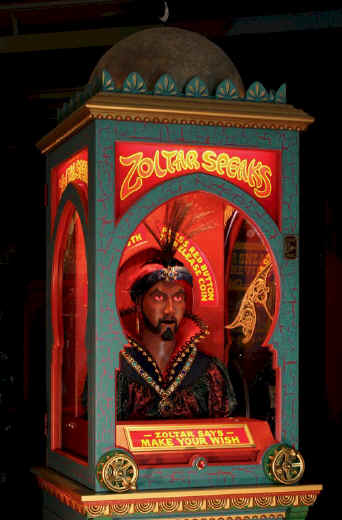 In
the movie Big a teenage boy, played by Tom Hanks, is told he is
too short for a carnival ride.
He puts a quarter into an unusual antique arcade fortune teller
machine called Zoltar Speaks. He wishes to be made big.
Zoltar dispenses a card that says, “Your wish is
granted.” He becomes
spooked after noticing the machine is unplugged.
Never the less he wakes up the next morning transformed into a
30-year-old man. In
the movie Big a teenage boy, played by Tom Hanks, is told he is
too short for a carnival ride.
He puts a quarter into an unusual antique arcade fortune teller
machine called Zoltar Speaks. He wishes to be made big.
Zoltar dispenses a card that says, “Your wish is
granted.” He becomes
spooked after noticing the machine is unplugged.
Never the less he wakes up the next morning transformed into a
30-year-old man.
Coin-operated fortune
telling machines were popular at amusement parks and penny arcades in
the 1930s and after. Those
were years that dropping coins into game slots seemed like the last
thing people would be doing with their money.
But actually, if a person had a spare penny or two, the arcades
were a cheap, temporary way to put their real-world problems on the
backburner.
The
fortune machines were simple: the Mystic Pen, for
instance, wrote out a “special” fortune for a player after he
inserted a penny. And
Exhibit Supply’s An Answer from Beyond had players ask
pertinent questions and then glean answers from a picture of the
all-knowing Egyptian mummy Ramasees, located just inside the cabinet.
A
few years later, arcades saw the coming of more elaborate fortune
telling booths, and in terms of coin-op artistry, these might just have
taken the cake. Inside the
beautifully finished wood cabinets, set behind glass and usually seen
from the chest up, there were mannequin tellers that weren’t just
life-sized, they were also incredibly life-like.
If you were going to pay cold hard cash for something as shady as
a randomly distributed fortune, at least someone who looked the part was
doing the distributing.
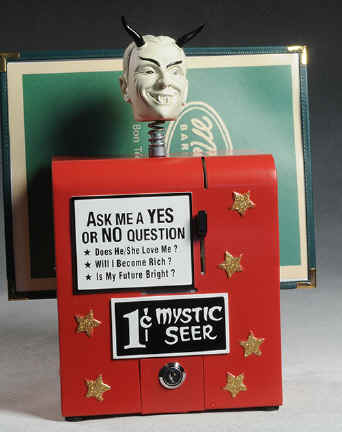 The
tellers were frequently costume-jewelry-and-fancy-robe-wearing women,
but sometimes these booths had models of bearded men and animals dipping
their toes in the pool of prediction, too. The tellers were shown to
nod, breathe, blink, and finger mystic objects like tarot cards and
tealeaves. And if a teller had a name like Grandma…well, who
wouldn’t believe the little prediction cards that she doled out? Later
fortune telling games had zodiac options—a player twisted the knob to
his particular sign—for added accuracy (which is, of course, not to
say that they weren’t accurate in the first place). The
tellers were frequently costume-jewelry-and-fancy-robe-wearing women,
but sometimes these booths had models of bearded men and animals dipping
their toes in the pool of prediction, too. The tellers were shown to
nod, breathe, blink, and finger mystic objects like tarot cards and
tealeaves. And if a teller had a name like Grandma…well, who
wouldn’t believe the little prediction cards that she doled out? Later
fortune telling games had zodiac options—a player twisted the knob to
his particular sign—for added accuracy (which is, of course, not to
say that they weren’t accurate in the first place).
Many
of the games built around this time were assembled with parts taken from
pre-war arcade games, because in the war years, new parts for
non-essential mechanical items couldn’t be obtained. In post-war
years, the 50’s and 60’s especially, old-fashioned arcade games came
back into vogue and were widely manufactured. There were still
mannequins, but they tended not to be as finely detailed as they were in
previous years. Sometimes
just the idea of a fortune teller was compelling enough. A shiny metal
“Swami” napkin holder, for instance, was eerily used in the “Nick
of Time” Twilight Zone episode, dispensing a whole lot more than
just napkins to its diner patron, played by a young William Shatner.
 One
of the most memorable players on the fortune teller block during the
70’s was Bacchus’ Madame Morgana.
Here, a woman’s face was projected onto a blank, head-shaped
screen, from whence she started to move and talk, and promptly dispensed
a player’s fate. When this disembodied favorite did her thing, it
looked as if she was speaking, and looking, directly at you. One
of the most memorable players on the fortune teller block during the
70’s was Bacchus’ Madame Morgana.
Here, a woman’s face was projected onto a blank, head-shaped
screen, from whence she started to move and talk, and promptly dispensed
a player’s fate. When this disembodied favorite did her thing, it
looked as if she was speaking, and looking, directly at you.
The
Zoltan booths came out in these same years. Again, the bearded
wise man inside the glass may not have had that 1930’s-type mannequin
authenticity, but he did offer a telephone handset which the player
picked up to hear his fortune. This little innovation merged the two
disparate worlds of telecommunication and fortune telling, and—one
never knows—may have paved the way for the future of paid fortune
tellers, psychic hotlines.
There
also is a fortune-telling machine named “Zoltan” that often
is confused with Zoltar. The
name "Zoltan" may have come from the Hungarian word for
Sultan and the figure was dressed like a sultan.
The first fortune-telling machines probably were made in the
1890s, and the first electric coin-operated machines in about 1910.
Experts say that Zoltan was introduced in 1965 and that
only 50 or 60 were made. After
the movie Big came out, some reproductions were made of
fiberglass. A dime went in
the slot. Later models
required a quarter.
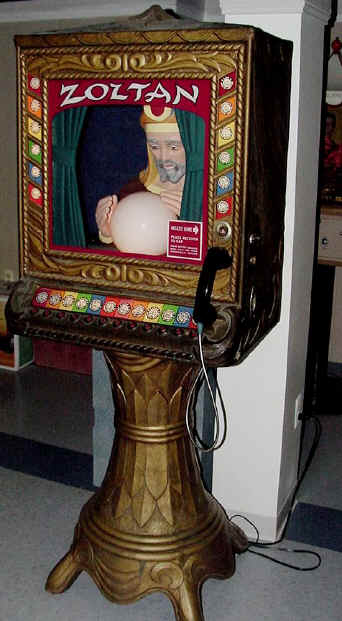 Zoltan
Fortune Teller is an
electromechanical fortuneteller game from Prophetron using a Cousino
endless loop tape cartridge, made in the late 60's through the early
70's. All the buttons
are wired in parallel; so pressing any button just starts the tape
system, which has 14 different fortunes, all about one minute in length.
The fortune plays and when done, a conductive tape on the tape loops
closes a switch, which turns off the tape player.
To play the player deposits a quarter, puts a receiver to their
ear and presses one of twelve zodiac sign buttons on the front of the
machine. When one of the
zodiac buttons is pushed, the crystal ball lights up brightly and
illuminates Zoltan’s face.
Then after a short pause, mystical background music fades in and Zoltan
begins speaking your fortune in a low voice with a heavy Hungarian
accent. Zoltan
usually begins his fortune telling with, "This is Zoltan
speaking" or "Greetings from Zoltan".
The predictions include things about your future, lucky numbers,
and favorable colors. Zoltan
Fortune Teller is an
electromechanical fortuneteller game from Prophetron using a Cousino
endless loop tape cartridge, made in the late 60's through the early
70's. All the buttons
are wired in parallel; so pressing any button just starts the tape
system, which has 14 different fortunes, all about one minute in length.
The fortune plays and when done, a conductive tape on the tape loops
closes a switch, which turns off the tape player.
To play the player deposits a quarter, puts a receiver to their
ear and presses one of twelve zodiac sign buttons on the front of the
machine. When one of the
zodiac buttons is pushed, the crystal ball lights up brightly and
illuminates Zoltan’s face.
Then after a short pause, mystical background music fades in and Zoltan
begins speaking your fortune in a low voice with a heavy Hungarian
accent. Zoltan
usually begins his fortune telling with, "This is Zoltan
speaking" or "Greetings from Zoltan".
The predictions include things about your future, lucky numbers,
and favorable colors.
The
most valued fortune telling machine today is the Gypsy.
She actually talks to you from two Edison cylinder machines
that're inside the mechanism. There are two coin slots, one for male and
one for female. Depending on where you put the coin, that's which Edison
cylinder machine, will be turned on at that point.
When you drop a nickel in the slot, her eyes would flash, her
teeth would chatter and her voice would come floating from a tube
extending out of the eight-foot-tall box.
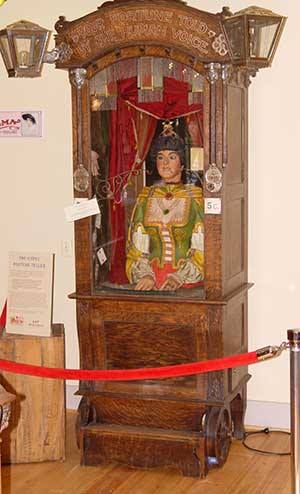 Collectors
realized the machine was one of two or three "verbal" fortune
tellers left in the world. Many
were interested in purchasing the Gypsy, including David
Copperfield. He wanted the Gypsy
to be the crown jewel in his collection of turn-of the century
penny-arcade games. It would occupy a place of pride among the
magician's mechanized Yacht Race, Temple of Mystery and various machines
that tested a person's strength. Collectors
realized the machine was one of two or three "verbal" fortune
tellers left in the world. Many
were interested in purchasing the Gypsy, including David
Copperfield. He wanted the Gypsy
to be the crown jewel in his collection of turn-of the century
penny-arcade games. It would occupy a place of pride among the
magician's mechanized Yacht Race, Temple of Mystery and various machines
that tested a person's strength.
But
Montana Heritage commission curators representing the Gypsy's
owner, the state of Montana, rejected the idea, saying cashing in on
this piece of history would be akin to selling their soul.
The
state inherited the Gypsy in 1998 when it paid $6.5 million to
buy nearly 250 buildings and their contents in Virginia City and nearby
Nevada City from the son of Charles Bovey.
The Montana collector spent years buying up the buildings to
preserve the two crumbling ghost towns and he stocked them with his
ever-growing collection of antique games, music machines and oddities.
The
Gypsy was made sometime around 1906 by the Mills Novelty Co. In
restoring her, the curators either replaced or repaired frayed, worn or
broken parts with exact replicas. When they couldn't find replicas or
period materials, they didn't replace the parts.
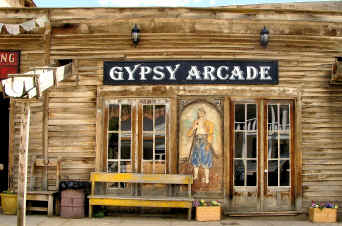 In
2008, they installed the Gypsy as the centerpiece of the Gypsy
Arcade amid the ancient wooden buildings of Virginia City's main street.
Calliope music spills out into the street, beckoning the tens of
thousands of visitors to enter and view the stereoscopes, shock tests,
tests of strength, fortune telling machines and love letter machines.
The Gypsy presides over the menagerie in the rear, ropes keeping
visitors at a distance. In
2008, they installed the Gypsy as the centerpiece of the Gypsy
Arcade amid the ancient wooden buildings of Virginia City's main street.
Calliope music spills out into the street, beckoning the tens of
thousands of visitors to enter and view the stereoscopes, shock tests,
tests of strength, fortune telling machines and love letter machines.
The Gypsy presides over the menagerie in the rear, ropes keeping
visitors at a distance.
Some
of the other more known and collectible fortune tellers are listed
below.
Madame
Zita
is a richly attired fortune teller in gypsy style. The Roover Brothers
manufactured the electric version around 1905.
There are only a handful of surviving original specimens.
It's among the most desirable electric tellers from the golden
age of automated machines. At
the turn of a handle the teller, a gypsy styled figure, reaches for a
card and drops it into the chute for the customer.
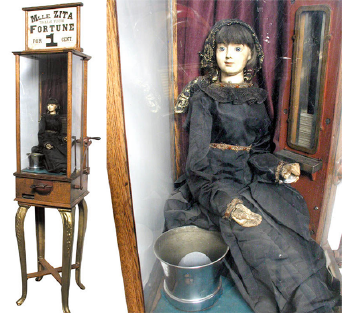 Princess
Doraldina was made
by the Doraldina Corp around 1928.
Her youth and beauty attract the arcade customer.
A wax head, real human hair and lifelike movements when granting
fortunes make the princess appear to be alive.
Her chest moves as she breathes, and her eyes roll as she
delivers a fortune. Princess
Doraldina was made
by the Doraldina Corp around 1928.
Her youth and beauty attract the arcade customer.
A wax head, real human hair and lifelike movements when granting
fortunes make the princess appear to be alive.
Her chest moves as she breathes, and her eyes roll as she
delivers a fortune.
William
Gent who lived in the Cleveland, Ohio area during the 1930s, made
Grandmothers Predictions. The wise old grandmother passes her hands
over the fortune telling cards and stops at the proper fortune. The card
falls into the tray below. International
Mutoscope later copied the wise Grandma fortune teller for a version
they produced which was mechanically identical but the cabinet was
different. Grandmother's
head moved left and right and nodded up and down, her hand moved over
the cards, her chest moving like she is breathing, and she of course
gave out a fortune card.
Geneco
Mfg., New York, made Geneco Gypsy Grandma Fortune Teller in the
1940s & 1950s. The
central attraction of the original boardwalk and arcades was the Gypsy
Grandma that came to life after a coin was deposited into a slot.
Once a selection was made using a rotary dial that illuminated
the player's astrological sign of 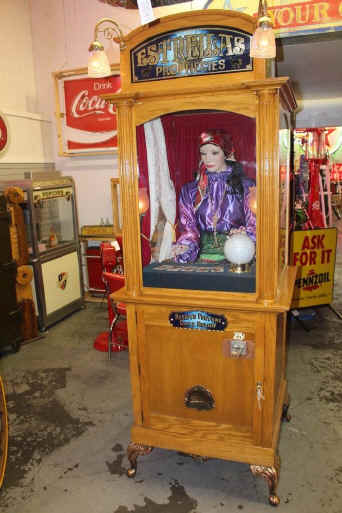 choice, the animated gypsy fortune
teller moved her head above a lighted crystal ball while she held a fan
of playing cards in her right hand and magic wand in her left hand.
Her right hand picked-up a fortune card from the enclosure that
she opened with her left hand. She
brought the card in front of her, turned her head, and then moved the
card over the cauldron and dropped it, which delivered the card to the
patron. She breathed during
this process too and turned her head left and right and nodded.
Some Genco Gypsy Grandmas had a speaker/microphone mounted
to the upper left of the front glass, and some did not.
The Speaker was not functional.
It was just there to fool the patron into thinking they could
talk to the Grandma. The front glass specified that you could ask
Grandma a yes or no question, and she would give an answer.
The Genco Gyspy Grandma was one of the more sophisticated
fortune tellers, much more complex than the 1957 Genco Horoscope
Grandma, which came out at about the same time, but delivered a
horoscope in addition to a fortune. choice, the animated gypsy fortune
teller moved her head above a lighted crystal ball while she held a fan
of playing cards in her right hand and magic wand in her left hand.
Her right hand picked-up a fortune card from the enclosure that
she opened with her left hand. She
brought the card in front of her, turned her head, and then moved the
card over the cauldron and dropped it, which delivered the card to the
patron. She breathed during
this process too and turned her head left and right and nodded.
Some Genco Gypsy Grandmas had a speaker/microphone mounted
to the upper left of the front glass, and some did not.
The Speaker was not functional.
It was just there to fool the patron into thinking they could
talk to the Grandma. The front glass specified that you could ask
Grandma a yes or no question, and she would give an answer.
The Genco Gyspy Grandma was one of the more sophisticated
fortune tellers, much more complex than the 1957 Genco Horoscope
Grandma, which came out at about the same time, but delivered a
horoscope in addition to a fortune.
Estrella's
Prophecies Fortune
Teller is a Coin-Op Gypsy-style Fortune Teller Machine.
She is a full size enclosed figure in an elaborate oak cabinet.
Her head moves from side to side, hand moves across the cards,
while her left hand raises and then she slowly dispenses a fortune card
through the ornate card slot.
Most of these
coin-operated fortune-telling machines sell for high prices.
Think
of it. A wish for a
coin…it has to be the greatest bargain of all time.
|